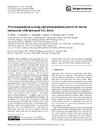Please use this identifier to cite or link to this item:
https://accedacris.ulpgc.es/jspui/handle/10553/73517
| Title: | Microzooplankton grazing and phytoplankton growth in marine mesocosms with increased CO2 levels | Authors: | Suffrian, K. Simonelli, P. Nejstgaard, J. C. Putzeys, S. Carotenuto, Y. Antia, A. N. |
UNESCO Clasification: | 251001 Oceanografía biológica | Keywords: | Calanus-Finmarchicus Carbon Diatoms Bloom Photosynthesis, et al |
Issue Date: | 2008 | Journal: | Biogeosciences | Abstract: | Microzooplankton grazing and algae growth responses to increasing pCO(2) levels (350, 700 and 1050 mu atm) were investigated in nitrate and phosphate fertilized mesocosms during the PeECE III experiment 2005. Grazing and growth rates were estimated by the dilution technique combined with taxon specific HPLC pigment analysis. Microzooplankton composition was determined by light microscopy. Despite a range of up to 3 times the present CO2 levels, there were no clear differences in any measured parameter between the different CO2 treatments. During days 3-9 of the experiment the algae community standing stock, measured as chlorophyll a (Chl-a), showed the highest instantaneous grow rates (k = 0.37-0.99 d(-1)) and increased from ca. 2-3 to 6-12 mu g l(-1), in all mesocosms. Afterwards the phytoplankton standing stock decreased in all mesocosms until the end of the experiment. The microzooplankton standing stock, that was mainly constituted by dinoflagellates and ciliates, varied between 23 and 130 mu g Cl-1 (corresponding to 1.9 and 10.8 mu mol Cl-1), peaking on day 13-15, apparently responding to the phytoplankton development. Instantaneous Chl-a growth rates were generally higher than the grazing rates, indicating only a limited overall effect of microzooplankton grazing on the most dominant phytoplankton. Diatoms and prymnesiophytes were significantly grazed (12-43% of the standing stock d(-1)) only in the prebloom phase when they were in low numbers, and in the post-bloom phase when they were already affected by low nutrients and/or viral lysis. The cyanobacteria populations appeared more affected by microzooplankton grazing which generally removed 20-65% of the standing stock per day. | URI: | https://accedacris.ulpgc.es/handle/10553/73517 | ISSN: | 1726-4170 | DOI: | 10.5194/bg-5-1145-2008 | Source: | Biogeosciences [ISSN 1726-4170], v. 5 (4), p. 1145-1156, (2008) |
| Appears in Collections: | Artículos |
SCOPUSTM
Citations
57
checked on Jun 8, 2025
WEB OF SCIENCETM
Citations
56
checked on Jun 8, 2025
Page view(s)
80
checked on Dec 28, 2024
Download(s)
87
checked on Dec 28, 2024
Google ScholarTM
Check
Altmetric
Share
Export metadata
Items in accedaCRIS are protected by copyright, with all rights reserved, unless otherwise indicated.
